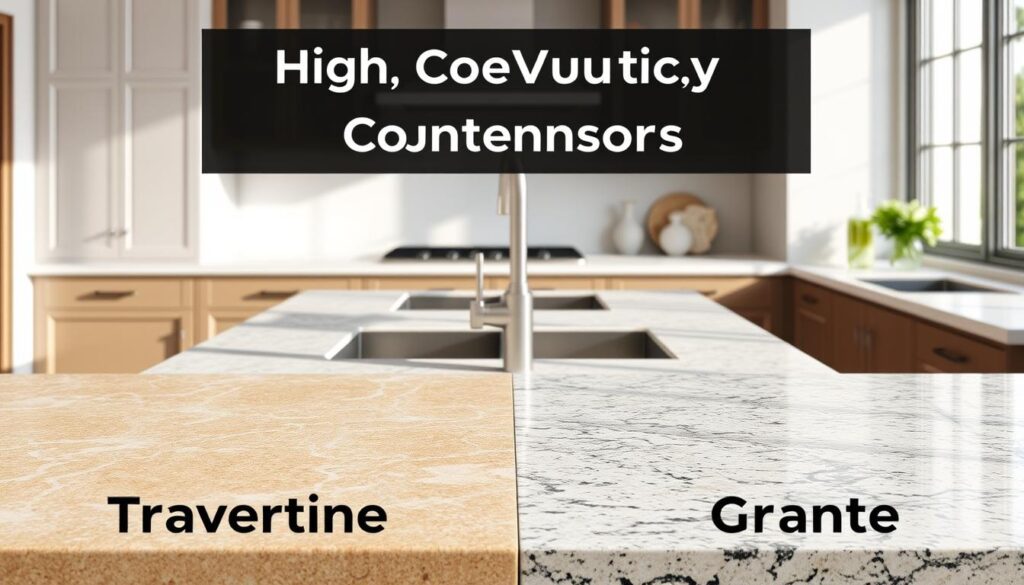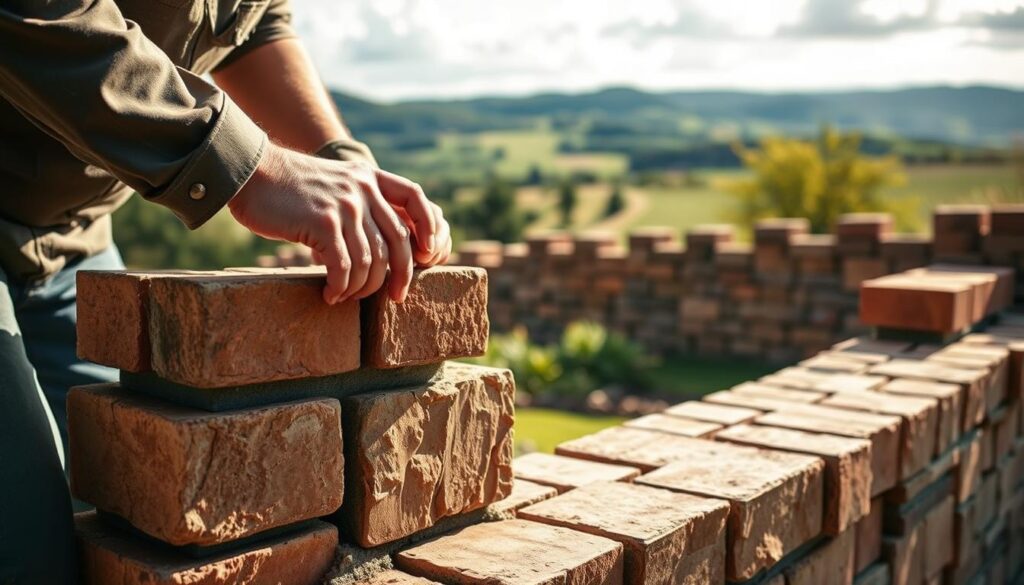Choosing the right natural stone is key when designing a new space or improving your home. You have many options, but Granite and Travertine are top picks for countertops.
Both offer great benefits in durability and style. But, they differ a lot in cost. Knowing these differences helps you make a choice that fits your needs and budget.
For a free estimate, talk to experts who can help. You can CALL NOW 650-418-2241 or visit https://hillsboroughmasonerypros.com for more info.
Key Takeaways
- Granite and Travertine have different durability characteristics.
- The cost of Granite and Travertine countertops varies.
- Style preferences play a significant role in choosing between Granite and Travertine.
- Professional guidance can help in making the right choice.
- A free estimate can provide clarity on the costs involved.
Understanding Travertine Countertops
Travertine countertops are loved for their natural beauty. They have unique qualities that make them stand out. Travertine comes from mineral springs, like hot springs. This makes it look special, with colors like white, tan, brown, and cream.
What is Travertine?
Travertine forms when calcium carbonate from springs settles. This takes thousands of years. It makes the stone beautiful and full of history. But, its porous nature means it needs care to last.
Key characteristics of travertine include:
- Natural, elegant appearance
- Variety of neutral tones
- Porous nature, requiring periodic sealing
Unique Characteristics of Travertine
Travertine is loved for its unique look. It brings warmth and character to any space. But, it needs regular care to stay beautiful.
| Characteristics | Description | Implications |
|---|---|---|
| Porous Nature | Travertine is formed with natural pores. | Requires periodic sealing to maintain durability. |
| Neutral Tones | Available in a range of neutral colors. | Offers versatility in design and décor. |
| Natural Patterns | Unique patterns formed during its creation. | Adds character and elegance to spaces. |
Knowing about travertine’s traits is key for homeowners. It’s beautiful but needs care. Make sure it fits your lifestyle and taste.
Understanding Granite Countertops
Granite countertops are loved by many homeowners. They mix durability with beauty. If you’re thinking about granite, knowing its benefits is key.
What is Granite?
Granite is a natural rock that forms slowly. It’s strong and durable. Granite can handle a lot of use, perfect for kitchens.
Granite comes in many colors and patterns. You can find one that matches your home’s look.
Unique Characteristics of Granite
Granite is special for many reasons. Here are some benefits:
- Durability: It’s tough against scratches and cracks.
- Heat Resistance: It can handle hot things without getting damaged.
- Aesthetic Appeal: It has many colors and patterns.
Let’s look at some key granite features:
| Characteristic | Description | Benefit |
|---|---|---|
| Durability | High resistance to scratches and cracks | Long-lasting |
| Heat Resistance | Can withstand high temperatures | Ideal for kitchens |
| Aesthetic Appeal | Variety of colors and patterns | Complements various décors |

Thinking about granite countertops? Know the good and bad. Granite is durable and looks great. But, it needs sealing to stay that way.
In short, granite countertops are a great choice. They’re strong and stylish. Knowing what granite is and its benefits helps you decide if it’s right for your home.
Durability Comparison: Travertine vs. Granite
It’s important to know how durable travertine and granite are. This helps you choose the best countertop for your home. Durability includes how well they resist scratches, heat, and how easy they are to keep clean.
Scratch Resistance
Granite is better at resisting scratches than travertine. Its dense material makes it less likely to chip or scratch. Travertine, being softer and more porous, is more likely to get scratched.
Here’s a quick comparison:
| Material | Scratch Resistance |
|---|---|
| Granite | High |
| Travertine | Moderate |
Heat Resistance
Both travertine and granite can handle heat, but granite is a bit better. Its denser structure helps it resist heat better. Always use trivets or mats under hot pans, no matter which you choose.
Maintenance Needs
Travertine needs more care than granite because it’s porous. It must be sealed often to avoid stains. Granite also benefits from sealing but is easier to keep up with.
Here’s a quick look at their maintenance needs:
| Material | Sealing Frequency | Maintenance Level |
|---|---|---|
| Travertine | Every 1-2 years | High |
| Granite | Every 5-10 years | Low to Moderate |
Cost Analysis: Travertine vs. Granite
Your budget is key when choosing between travertine and granite for countertops. Look at more than just the initial cost. Consider installation costs and long-term value too.
Initial Costs of Materials
The cost of materials is a big deal. Travertine costs between $25 to $50 per square foot. This makes it cheaper upfront. Granite costs from $35 to $75 per square foot, depending on quality and type.
Granite’s price changes because of its availability, quality, and installation complexity. Even though travertine is cheaper, some high-end travertine can be as pricey as granite’s lower end.

Installation Costs
Installation costs add up. Both travertine and granite need pros because of their weight and fitting needs. The cost varies by location, job complexity, and installer skill.
Expect to pay $10 to $30 per square foot for installation. Get quotes from different installers to find the best deal for your project.
Long-term Value and Resale
Travertine might be cheaper at first, but granite lasts longer. Granite’s durability and looks can boost your home’s resale value. This makes it a smart choice for resale.
Travertine also offers a luxurious look. To get the most value, take good care of it. Knowing the costs and benefits helps you choose wisely, fitting your budget and improving your home’s value.
Style and Aesthetics: Travertine vs. Granite
Your home’s look can change a lot with travertine or granite countertops. Both materials make your kitchen or bathroom look better.
Travertine has a natural, earthy feel. It’s warm and adds character. It usually comes in beige, brown, and cream colors. Granite, on the other hand, has many colors and patterns. It fits many styles.
Color and Design Options
Granite has more color and design choices. It comes in many colors, from calm neutrals to bright ones. It also has unique patterns. Travertine has fewer colors but can be finished in different ways to show its natural beauty.
- Travertine: Offers a natural, earthy aesthetic with limited color variations.
- Granite: Provides a wide array of colors and patterns, suitable for diverse décor styles.
Finishes Available
Both travertine and granite have different finishes. These finishes change how they look and work.
- Polished Finish: Makes the stone’s color and pattern stand out, with a shiny look.
- Honed Finish: Has a matte look, which is less shiny and more rustic.
- Tumbled Finish: Makes the stone look aged and textured, great for travertine.
Suitability for Various Décors
Choosing between travertine and granite depends on your style and what you want your home to look like. Travertine is good for rustic or traditional looks. Granite works well with both modern and classic designs because it’s so versatile.
So, pick travertine or granite based on your style and needs. It’s important to think about how each material fits your home’s look and your practical needs.
Choosing the Right Countertop for Your Home
The right countertop can make your home look and feel better. You need to think about what you need and like. When choosing between travertine and granite, many things matter.
Factors to Consider
When picking a countertop, think about durability, maintenance needs, and cost. These things will make you happy with your choice.
Durability is key because it shows how well the countertop lasts. How easy it is to keep clean is also important. And, the cost of the countertop matters a lot.
| Countertop Material | Durability | Maintenance Needs | Cost |
|---|---|---|---|
| Travertine | Moderate | High | $30-$75 per sq. ft. |
| Granite | High | Moderate | $40-$100 per sq. ft. |
Personal Style Preferences
Your style and your home’s look are important too. Both travertine and granite have many colors and finishes. You can pick the one that fits your home best.
Travertine has a natural beauty with holes and a warm look. It’s great for rustic or traditional homes. Granite has a shiny look and many colors. It’s perfect for modern homes.
Lifestyle and Usage
How you live and use your countertops matters too. If you cook a lot, you need a countertop that can handle it.
Granite is good for busy kitchens because it’s strong and doesn’t get damaged easily. Travertine is good for those who want a unique look and don’t mind cleaning it often.
Choosing between travertine and granite depends on what you like, how you live, and your budget.
Installation Considerations
Putting in travertine or granite countertops needs careful planning. It’s more than just putting them in place. It includes getting ready, measuring right, and skilled work for a perfect fit and look.
Professional Installation vs. DIY
DIY installation is possible for those with experience and the right tools. But, getting a pro to do it is best for travertine and granite countertops. They make sure the countertops last longer and look better.
Experts have the skills and tools needed for a precise fit and finish. They also know the best ways to seal and keep your countertops looking good.
| Aspect | Professional Installation | DIY Installation |
|---|---|---|
| Expertise | Highly skilled professionals | Varies based on individual’s experience |
| Cost | Higher upfront cost | Lower upfront cost, but costly mistakes can happen |
| Time | Faster completion | Depends on individual’s availability and skill level |
Timeline for Installation
The time it takes to install travertine or granite countertops varies. It depends on how complex the project is and when materials are ready.
Usually, it takes a few days to a few weeks to finish the installation.
Eco-Friendliness of Materials
When you think about travertine and granite countertops, think about their sustainability. Both are natural stones, but they affect the environment differently.
Travertine is seen as a renewable resource. It forms over time from calcium carbonate in hot springs. This means travertine can be replaced, slowly.
Sustainability of Travertine
Getting travertine from the quarry can harm the environment. It uses a lot of energy and can hurt habitats. But, many suppliers are now using better methods. They reclaim land and cut down on waste.
Sustainability of Granite
Granite is very strong and lasts a long time. This means it doesn’t need to be replaced often. It’s good for the planet because it lasts longer. But, getting granite from the quarry also uses a lot of energy and can pollute.
The greenness of travertine and granite depends on how they are sourced and quarried. Also, local rules play a big part. Choosing suppliers who care about the planet can help reduce harm to the environment.
Getting a Free Estimate
Now that you’ve thought about travertine and granite countertops, it’s time to move forward. Our experts are ready to give you a free estimate for your project. This will help you start your home renovation.
How to Begin the Process
To start, just call us at 650-418-2241 or visit hillsboroughmasonerypros.com. Our team will help you from picking the right material to installing it. We make sure it’s easy for you.
Choosing us means you get our knowledge in travertine and granite countertops. Your new countertops will be amazing. Contact us today for your free estimate and make your kitchen or bathroom dream come true.

